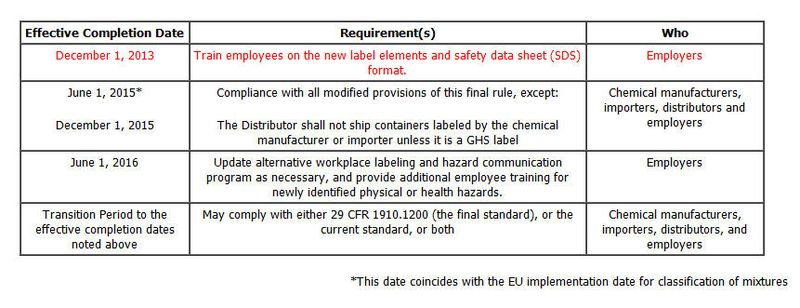Global Harmonization Standard Reminder
The first date in OSHA’s Global Harmonization Standard (GHS) is coming up before you know it. OSHA is requiring that employees are trained on the new label elements (i.e., pictograms, hazard statements, precautionary statements, and signal words) and SDS format by December 1, 2013, while full compliance with the final rule will begin in 2015.
OSHA believes that American workplaces will soon begin to receive labels and SDSs that are consistent with the GHS, since many American and foreign chemical manufacturers have already begun to produce HazCom 2012/GHS-compliant labels and SDSs. It is important to ensure that when employees begin to see the new labels and SDSs in their workplaces, they will be familiar with them, understand how to use them, and access the information effectively. In today’s world, a large percentage of tasks require the use of some type of chemical. While many chemicals are classed as "hazardous," we can use these chemicals safely if we bear in mind that they must be used cautiously. Just because we are familiar with a chemical doesn’t mean that we should regard it lightly. Needed precautions must be taken every time we handle that chemical, even if it is for the 100th or 1,000th time.
The major changes to the existing Hazard Communication Standard include:
- Hazard Classification: The definitions of hazard have been changed to provide specific criteria for classification of health and physical hazards, as well as classification of mixtures. These specific criteria will help to ensure that evaluations of hazardous effects are consistent across manufacturers, and that labels and safety data sheets are more accurate as a result.
- Labels: Chemical manufacturers and importers will be required to provide a label that includes a harmonized signal word, pictogram, and hazard statement for each hazard class and category. Precautionary statements must also be provided.
- Safety Data Sheets: Will now have a specified 16-section format.
Timeline of events:

The new format of an SDS will include 16 sections:
Section 1. Identification
Section 2. Hazard(s) identification
Section 3. Composition/information on ingredients
Section 4. First-Aid measures
Section 5. Fire-fighting measures
Section 6. Accidental release measures
Section 7. Handling and storage
Section 8. Exposure controls/personal protection
Section 9. Physical and chemical properties
Section 10. Stability and reactivity
Section 11. Toxicological information
Section 12. Ecological information
Section 13. Disposal considerations
Section 14. Transport information
Section 15. Regulatory information
Section 16. Other information, including date of preparation or last revision
This is just a reminder. For more detailed information see the following links:
- OSHA’s website: https://www.osha.gov/dsg/hazcom/
- MEMIC customer's can also access a recorded webinar on this topic through MEMIC's Safety Director.
